Bournemouth Beach Sand Replenishment
In mid December 2006 work commenced to replenish the sand on Bournemouth beach with the work being completed in just over a month of working 24 hours a day including Christmas. It was a fascinating engineering project which I followed closely throughout the period. The map below shows in yellow the extent of the replenishment during this period.
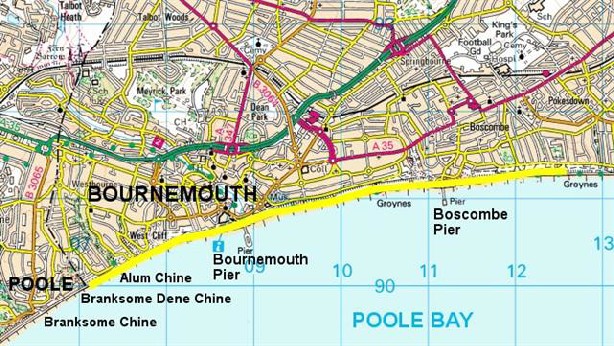
The Background
The standard of flood and coastal protection in Poole Bay depends mainly on the level and width of its beaches. During the 20th Century the cliffs were protected from erosion by building concrete seawalls, promenades and groynes. This allowed houses to be built on the cliff tops, but it also stopped the natural supply of sand and gravel to the shore and in the last 36 years Bournemouth beach has been replenished on four previous occasions so is now effectively an artificial beach.
The Method
The sandy material used for the replenishment came from a Licensed Dredging Area to the east of the Isle of Wight and was transported by the Oranje . To give her full title the Oranje is a trailing suction hopper dredger (or TSHD).
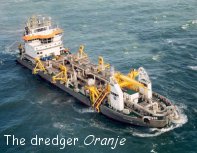
She trails a suction pipe on the seabed and loads sand into an open hopper.
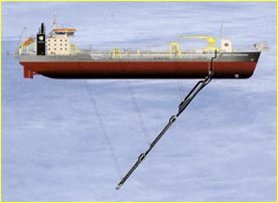
When the hopper is full she raises the suction pipe and sails to the seaward end of the sinkerline at Bournemouth. She is coupled with the floating section of the pipe and the sand is pumped from the hopper on to the beach.
The Execution
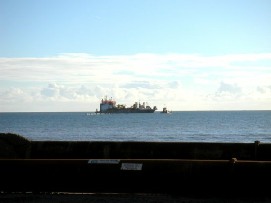
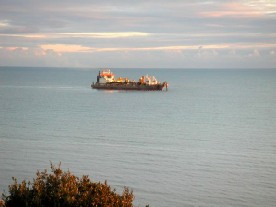
The dredger came in as close as possible to the beach but the waters of Poole Bay are shallow; so the material was pumped ashore through a 1150m long pipe known as a 'sinkerline' which connected the dredger with the beach.
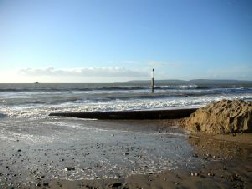

This sinkerline was constructed locally, at Branksome Chine on the Poole/Bournemouth boundary. Bournemouth beach is interrupted by high level timber groynes, but the replenishment at Poole last winter has created a wide, flat beach with the old groynes buried below sand. The conditions at Poole were therefore ideal for fabricating and welding the pipework. Once complete, the sinkerline stretched from Branksome Chine to Flaghead Chine; small sand ‘bridges’ were created during fabrication to allow public access to the shoreline until it was moved offshore and towed to Bournemouth.
Each section of sinkerline was 18m long, 1.1m in diameter and weighs 13 tonnes and the steel that made up the sections was 1" thick and this particular sinkerline was last used on a replenishment project in Africa. Once made up it was towed to a position between Bournemouth and Boscombe piers. With one end at the shoreline and the other out at sea and it was sunk to the seabed.
At the seaward end the sinkerline was coupled to a flexible riser pipe section and flexible floating pipeline. During operations the multicat (support vessel) Zwerver II took care of the floating section and connected it to the loaded dredger when she arrived at the Bournemouth coast via a bespoke coupling ball-
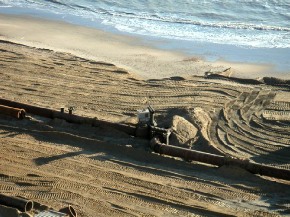
At the landward end the sinkerline was fitted with a steel flange from which sections of onshore pipeline (approximately 12m long) could be coupled to discharge sand to the required locations. Sand was mixed with a considerable amount of water in the dredger's hopper to assist it being pumped through the 1,150m sinkerline and along the onshore pipeline.


On the beach horseshoe-
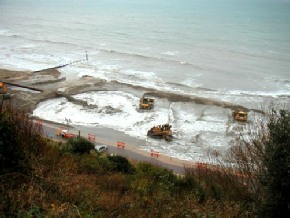
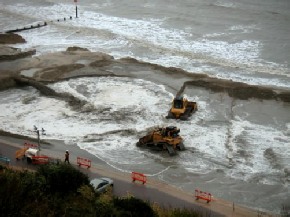

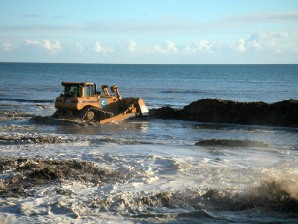
Measuring quantities pumped ashore
There are two factors to take into account when estimating the quantity of sand reaching the beach. The amount referred to as "pumped ashore" is recorded by the dredger and it is necessary to allow for a 'bulking factor' of 1.2 due to the sand being mixed with water in the hopper. For instance, if 10,000m3 is recorded has having been pumped from the hopper it would equate to about 8,333m3 material actually arriving at the beach.
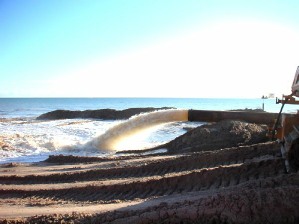
It is then necessary to allow for up to 15% of that 8,333m3 being lost to the foreshore during pumping & draining, so only 7,100m3 might be left on the beach. Losses can depend on the weather; the stormier the conditions, the larger the losses are likely to be.
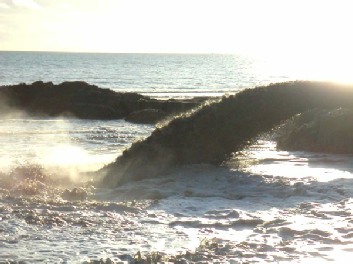
The beach was independently surveyed on a daily basis, comparing levels and widths to a baseline survey carried out before work commenced; in that way there was an accurate picture of how much sand had actually been delivered. Westminster Dredging were contracted to replenish the beaches by 700,000m3 not simply to pump 700,000m3, so the amount recorded as pumped (e.g. the amounts mentioned in our project diary) would actually total some 900,000m3 or more.
Further Work
Bournemouth’s existing timber groynes will last another 8 years or so, after which consideration will be given as to what should replace them; perhaps rock groynes or offshore reefs.
In the past the Bournemouth beach has been replenished at intervals of 15 years or so, by which time most of the sand has been lost. For the next 3 years small scale top-
For a photograph gallery of the month’s work click here